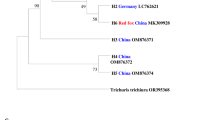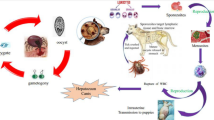Abstract
Fasciola hepatica is a helminth parasite with a worldwide distribution, which can cause chronic liver disease, fasciolosis, leading to economic losses in the livestock and public health in many countries. Control is mostly reliant on the use of drugs, and as a result, drug resistance has now emerged. The identification of F. hepatica genes involved in interaction between the parasite and host immune system is utmost important to elucidate the evasion mechanisms of the parasite and develop more effective strategies against fasciolosis. In this study, we aimed to identify molecules in F. hepatica excretory and secretory products (FhESPs) interacting with the host peripheral blood mononuclear cells (PBMCs), Th1-like cytokines (IL2 and IFN-γ), and Th17-like cytokines (IL17) by Co-IP combined with tandem mass spectrometry. The results showed that 14, 16, and 9 proteins in FhESPs could bind with IL2, IL17, and IFN-γ, respectively, which indicated that adult F. hepatica may evade the host immune responses through directly interplaying with cytokines. In addition, nine proteins in FhESPs could adhere to PBMCs. Our findings provided potential targets as immuno-regulators, and will be helpful to elucidate the molecular basis of host–parasite interactions and search for new potential proteins as vaccine and drug target candidates.




Similar content being viewed by others
References
Cancela M, Ruétalo N, Dell’Oca N, da Silva E, Smircich P, Rinaldi G, Roche L, Carmona C, Alvarez-Valín F, Zaha A, Tort JF (2010) Survey of transcripts expressed by the invasive juvenile stage of the liver fluke Fasciola hepatica. BMC Genomics 11:227
Cervi L, Rossi G, Masih DT (1999) Potential role for excretory-secretory forms of glutathione-S-transferase (GST) in Fasciola hepatica. Parasitology 119(Pt 6):627–633
Donnelly SL, O’Neill SM, Sekiya M, Mulcahy G, Dalton JP (2005) Thioredoxin peroxide secreted by Fasciola hepatica induces the alternative activation of macrophages. Infect Immun 73(1):166–173
Donnelly S, Stack CM, O’Neill SM, Sayed AA, Williams DL, Dalton JP (2008) Helminth 2-Cysperoxiredoxin drives Th2 responses through a mechanism involving alternatively activated macrophages. FASEB J 22:4022–4032
Falcón C, Carranza F, Martínez FF, Knubel CP, Masih DT, Motrán CC, Cervi L (2010) Excretory-secretory products (ESP) from Fasciola hepatica induce tolerogenic properties in myeloid dendritic cells. Vet Immunol Immunopathol 137(1–2):36–46
Figueroa-Santiago O, Espino AM (2014) Fasciola hepatica fatty acid binding protein induces the alternative activation of human macrophages. Infect Immun 82(12):5005–5012
Finlay CM, Walsh KP, Mills KH (2014) Induction of regulatory cells by helminth parasites: exploitation for the treatment of inflammatory diseases. Immunol Rev 259:206–230
Flynn RJ, Mulcahy G (2008) Possible role for Toll-like receptors in interaction of Fasciola hepatica excretory/secretory products with bovine macrophages. Infect Immun 76:678–684
Flynn RJ, Irwin JA, Olivier M, Sekiya M, Dalton JP, Mulcahy G (2007) Alternative activation of ruminant macrophages by Fasciola hepatica. Vet Immunol Immunopathol 120:31–40
Jefferies JR, Campbell AM, van Rossum AJ, Barrett J, Brophy PM (2001) Proteomic analysis of Fasciola hepatica excretory-secretory products. Proteomics 1(9):1128–1132
Knox DP, Redmond DL, Skuce PJ, Newlands GF (2001) The contribution of molecular biology to the development of vaccines against nematode and trematode parasites of domestic ruminants. Vet Parasitol 101(3–4):311–335
Maizels RM, Yazdanbakhsh M (2008) T-cell regulation in helminth parasite infections: implications for inflammatory diseases. Chem Immunol Allergy 94:112–123
Mas-Coma S, Bargues MD, Valero MA (2005) Fascioliasis and other plant-borne trematode zoonoses. Int J Parasitol 35(11–12):1255–1278
Meemon K, Sobhon P (2015) Juvenile-specific cathepsin proteases in Fasciola spp.: their characteristics and vaccine efficacies. Parasitol Res 114(8):2807–2813
Milbourne EA, Howell MJ (1993) Eosinophil differentiation in response to Fasciola hepatica and its excretory/secretory antigens. Int J Parasitol 23(8):1005–1009
Moreau E, Chauvin A (2010) Immunity against helminths: interactions with the host and the intercurrent infections. J Biomed Biotechnol 2010:428593
Moreau E, Hervé S, Yu ZW, Alain C (2002) Modulation of sheep lymphocyte responses by Fasciola hepatica excretory–secretory products. Vet Parasitol 108(3):207–215
Novobilský A, Kasný M, Mikes L, Kovarcík K, Koudela B (2007) Humoral immune responses during experimental infection with Fascioloides magna and Fasciola hepatica in goats and comparison of their excretory/secretory products. Parasitol Res 101(2):357–364
O’Neill SM, Brady MT, Callanan JJ, Mulcahy G, Joyce P, Mills KH, Dalton JP (2000) Fasciola hepatica infection downregulates Th1 responses in mice. Parasite Immunol 22(3):147–155
O’Neill SM, Mills KH, Dalton JP (2001) Fasciola hepatica cathepsin L cysteine proteinase suppresses Bordetella pertussis-specific interferon-γ production in vivo. Parasite Immunol 23(10):541–547
Piedrafita D, Parsons JC, Sandeman RM, Wood PR, Estuningsih SE, Partoutomo S, Spithill TW (2001) Antibody-dependent cell-mediated cytotoxicity to newly excysted juvenile Fasciola hepatica in vitro is mediated by reactive nitrogen intermediates. Parasite Immunol 23(9):473–482
Piedrafita D, Spithill TW, Smith RE, Raadsma HW (2010) Improving animal and human health through understanding liver fluke immunology. Parasite Immunol 32(8):572–581
Prowse RK, Chaplin P, Robinson HC, Spithill TW (2002) Fasciola hepatica cathepsin L suppresses sheep lymphocyte proliferation in vitro and modulate surface CD4 expression on human and ovine T cells. Parasite Immunol 24(2):57–66
Robinson MW, Donnelly S, Hutchinson AT, To J, Taylor NL, Norton RS, Perugini MA, Dalton JP (2011) A family of helminth molecules that modulate innate cell responses via molecular mimicry of host antimicrobial peptides. PLoS Pathog 7(5):e1002042
Robinson MW, Alvarado R, To J, Hutchinson AT, Dowdell SN, Lund M, Turnbull L, Whitchurch CB, O’Brien BA, Dalton JP, Donnelly S (2012) A helminth cathelicidin-like protein suppresses antigen processing and presentation in macrophages via inhibition of lysosomal vATPase. FASEB J 26(11):4614–4627
Walsh KP, Brady MT, Finlay CM, Boon L, Mills KH (2009) Infection with a helminth parasite attenuates autoimmunity through TGF-beta-mediated suppression of Th17 and Th1 responses. J Immunol 183(3):1577–1586
WHO (2006) Report of the WHO informal meeting on use of triclabendazole in fascioliasis control
WHO (2012) Accelerating work to overcome the global impact of neglected tropical diseases; a roadmap for implementation – executive summary
Young ND, Jex AR, Cantacessi C, Hall RS, Campbell BE, Spithill TW, Tangkawattana S, Tangkawattana P, Laha T, Gasser RB (2011) A portrait of the transcriptome of the neglected trematode, Fasciola gigantica—biological and biotechnological implications. PLoS Negl Trop Dis 5(2):e1004
Zhang W, Moreau E, Peigne F, Huang W, Chauvin A (2005) Comparison of modulation of sheep, mouse and buffalo lymphocyte responses by Fasciola hepatica and Fasciola gigantica excretory-secretory products. Parasitol Res 95(5):333–338
Zhu Y, Xu H, Chen H, Xie J, Shi M, Shen B, Deng X, Liu C, Zhan X, Peng C (2014) Proteomic analysis of solid pseudopapillary tumor of the pancreas reveals dysfunction of the endoplasmic reticulum protein processing pathway. Mol Cell Proteomics 13(10):2593–2603
Acknowledgments
Project support was provided by the “National Key Basic Research Program (973 Program) of China” (Grant no. 2015CB150300). The authors thank Shanghai Applied Protein Technology Co. Ltd., for technical assistance in LC-MS/MS analysis.
Author information
Authors and Affiliations
Corresponding author
Ethics declarations
Conflict of interest
The authors declare that they have no competing interests.
Rights and permissions
About this article
Cite this article
Liu, Q., Huang, SY., Yue, DM. et al. Proteomic analysis of Fasciola hepatica excretory and secretory products (FhESPs) involved in interacting with host PBMCs and cytokines by shotgun LC-MS/MS. Parasitol Res 116, 627–635 (2017). https://doi.org/10.1007/s00436-016-5327-4
Received:
Accepted:
Published:
Issue Date:
DOI: https://doi.org/10.1007/s00436-016-5327-4




